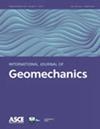Mathematical Treatment of Bimodality for the Safety Factor in Riverbank Stability Analysis Using Cusp Catastrophe
IF 3.3
2区 工程技术
Q2 ENGINEERING, GEOLOGICAL
引用次数: 0
Abstract
The safety factor (SF) in riverbank stability problems for noncohesive soils is treated mathematically in this article to unravel its inherent bimodality, as stipulated by the cusp catastrophe technique in a hyperspace. The developed methodology may be contrasted with traditional approaches delineating the SF space to failure and operational states. The emerging three states are a significant shift from traditional treatments overlooking bimodality. The mathematical treatment presented in the technical note incorporates classic soil equations for noncohesive soils into the cusp catastrophe technique, with clear formulations at multiple levels of a potential function, including the energy level. The integrated mathematical expressions use soil properties to express lower order properties such as catastrophe flags, for example, bifurcation sets, hysteresis, and bimodality delineating sudden and gradual change in the state of a system. These equations show that even the SF of operational states depends on soil properties and gravity, and therefore a safe use of the SF requires a deep knowledge of the SF hyperspace.Practical ApplicationsPractical applications of the new mathematical development presented in the technical note may be viewed in three steps. In Step 1, the tacit nature of the cusp catastrophe bimodality of safety factor in riverbank stability problems needs to be tested through experimental data. The laboratory tests and fieldwork can be designed to encompass the full range of cases comprising: (i) the failure region; (ii) the operational region; and (iii) their bimodal zone. In Step 2, the existence of the three cases is verified by various applications to underpin the dependency of the safety factor on soil parameters. In Step 3, this new knowledge is realized by wide applications to gain an insight into behaviors of safety factors in wide-ranging problems such as natural slopes, channels, embankments, riverbanks, and levees.尖峰突变河堤稳定分析中安全系数双峰的数学处理
本文对非粘性土河岸稳定问题中的安全系数(SF)进行了数学处理,揭示了其固有的双峰性,这是由超空间中的尖点突变技术规定的。所开发的方法可以与描述SF空间到故障和运行状态的传统方法进行对比。新兴的三态是对忽视双峰性的传统治疗的重大转变。技术说明中提出的数学处理方法将非粘性土壤的经典土壤方程纳入尖点突变技术,在包括能级在内的势函数的多个级别上有明确的公式。集成的数学表达式使用土壤属性来表示低阶属性,如突变标志,例如分岔集、滞后和描述系统状态的突然和逐渐变化的双峰性。这些方程表明,即使是运行状态的SF也取决于土壤性质和重力,因此安全使用SF需要对SF超空间有深入的了解。实际应用技术说明中提出的新数学发展的实际应用可以分三步看。在步骤1中,需要通过实验数据检验河岸稳定问题中安全系数尖峰突变双峰的默示性。实验室测试和实地工作可以设计成涵盖各种情况,包括:(i)失效区域;行动区域;(iii)它们的双峰区。在步骤2中,通过各种应用验证这三种情况的存在,以支持安全系数对土壤参数的依赖性。在步骤3中,这些新知识通过广泛的应用来实现,以深入了解安全因素在广泛问题中的行为,如天然斜坡,渠道,堤防,河岸和堤防。
本文章由计算机程序翻译,如有差异,请以英文原文为准。
求助全文
约1分钟内获得全文
求助全文
来源期刊

International Journal of Geomechanics
ENGINEERING, GEOLOGICAL-
CiteScore
6.40
自引率
13.50%
发文量
374
期刊介绍:
The International Journal of Geomechanics (IJOG) focuses on geomechanics with emphasis on theoretical aspects, including computational and analytical methods and related validations. Applications of interdisciplinary topics such as geotechnical and geoenvironmental engineering, mining and geological engineering, rock and blasting engineering, underground structures, infrastructure and pavement engineering, petroleum engineering, engineering geophysics, offshore and marine geotechnology, geothermal energy, lunar and planetary engineering, and ice mechanics fall within the scope of the journal. Specific topics covered include numerical and analytical methods; constitutive modeling including elasticity, plasticity, creep, localization, fracture and instabilities; neural networks, expert systems, optimization and reliability; statics and dynamics of interacting structures and foundations; liquid and gas flow through geologic media, contaminant transport and groundwater problems; borehole stability, geohazards such as earthquakes, landslides and subsidence; soil/rock improvement; and the development of model validations using laboratory and field measurements.
 求助内容:
求助内容: 应助结果提醒方式:
应助结果提醒方式:


